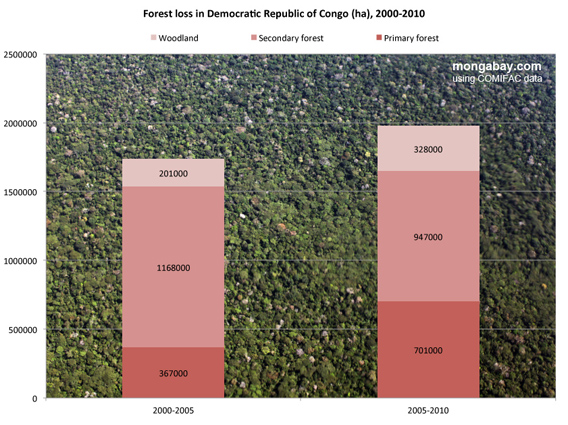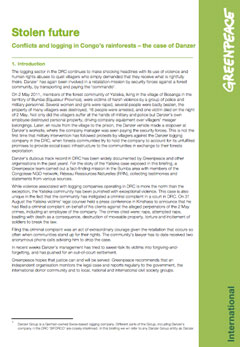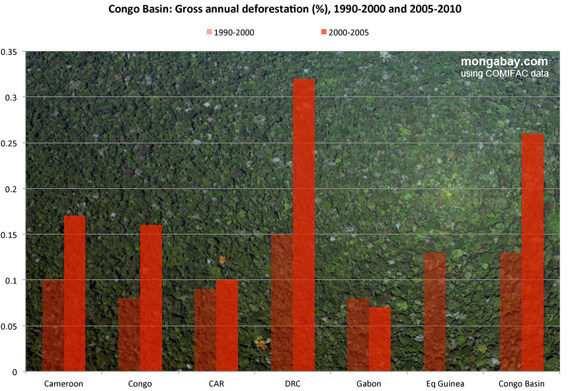
Deforestation by forest type/classification in DRC, 2000-2005 and 2005-2010. Click image to enlarge.
Danzer, a Swiss-German forestry company that has been heavily criticized by environmentalists for its logging practices in the Democratic Republic of Congo (DRC), has sold its operations in the Central African country, reports Greenpeace.
“Effective February 23rd, its subsidiary Siforco (which holds logging rights to around 2.1 million hectares of forest) was ceded to American-owned Groupe Blattner Elwyn (GBE),” said Greenpeace in a statement. “This ends 40 years of Danzer’s involvement in the DRC, a time that was all too often characterized by social conflicts and destruction of tropical rainforest.”
Danzer drew the ire of Greenpeace and other environmental groups for its logging of primary rainforests and its alleged links to incidents of violence against local community members, including a 2011 confrontation that resulted in one death. Victims of the violence in that most recent case subsequently filed suit against Danzer.
 Greenpeace’s Stolen Future documented the conflict between Danzer and local villagers. [Click image for PDF] |
Greenpeace says GBE may not be an improvement over Danzer.
“Other members of the Blattner family are involved in the logging sector via Safbois in Orientale province,” the group said. “In 2008 Greenpeace reported on Safbois’ illegal logging activities and social conflicts in Yafunga. GBE has been involved in infrastructure and agribusiness, amongst other activities.”
“GBE has – as far as we know – not yet released information on their plans, but according to Danzer, they ‘intend to follow our industrial and forest management concept.'”
GBE has already indicated that it won’t pursue Forest Stewardship Council (FSC) certification for its operations, seen as a good-faith commitment to basic environmental standards.
Greenpeace has been critical of FSC-certification in DRC, arguing that logging in the region is rarely well-managed and often leads to outright deforestation.
“In the rainforests of the Congo Basin, industrial loggers cut out the most commercially valuable trees, pack up their chainsaws, and go on to find new, pristine forest. What’s left behind for local communities is a depleted forest resource, disrupted social structures, and lost jobs,” the group said. “The logging frontier moves deeper and deeper into the remaining intact rainforest areas of the Congo Basin, exposing vast new areas to destruction.”
As an FSC member, Greenpeace has for years pushed to limit certification of logging in old-growth tropical forests and earlier this year urged the body to reject planned changes to its principles and criteria (P&C) due to what it sees as a lack of sufficient safeguards.
“We are deeply troubled that a ‘yes’ vote on the new proposed P&C will lock-‐in, for many years to come, a policy and standard that sacrifice key environmental values,” Greenpeace said in a January 2012 statement. “This will set back the credibility of the FSC system to assure customers that products are indeed environmentally responsible and undermine our collective efforts to date to ensure FSC certification is not used to ‘green wash’ environmentally destructive forest management practices.”

Deforestation in the Congo Basin. Click image to enlarge.
Logging in DRC remains controversial. In 2009, the DRC cancelled over 90 logging concessions after a six month analysis with the World Bank found that the concessions were granted either under questionable circumstances, but a number of these concessions have since been re-legalized. Research has linked logging operations to poaching and colonization of previously inaccessible regions.
The rainforests in the Congo Basin are second only in extent to those in the Amazon. But a report issued last week by the Central African Forests Commission (COMIFAC) and members of the Congo Basin Forest Partnership showed that the region’s annual gross deforestation rate doubled from 0.13 percent to 0.26 percent between the 1990s and the 2000-2005 period. Logging was a primary driver of deforestation and forest degradation.
Related articles